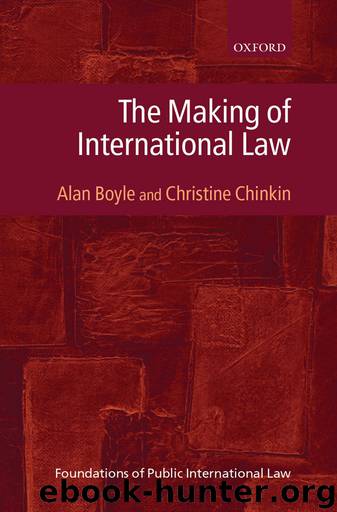The Making of International Law (Foundations of Public International Law) by Boyle Alan & Chinkin Christine

Author:Boyle, Alan & Chinkin, Christine [Boyle, Alan]
Language: eng
Format: epub
Publisher: Oxford University Press, USA
Published: 2007-02-22T00:00:00+00:00
6. Codification by Other Bodies
6.1The International Committee of the Red Cross
In Chapter 2 we noted briefly the participation of the International Committee of the Red Cross (ICRC) in promoting and negotiating treaties on international humanitarian law. Part of the ICRC’s role in this respect is to keep the treaties up-to-date, based on its experience in the field and its understanding of developments in modern warfare. Although formally an NGO, the Statutes of the ICRC are adopted by conferences in which states participate, and the ICRC functions in many respects as the competent organisation for the 1949 Geneva Conventions and their later Protocols, under which it has important powers and responsibilities.194 It has its own legal advisers and secretariat, and as we saw earlier, it also enjoys observer status at the UN, enabling it to participate actively in UN law-making. Although the Geneva Conventions have attained near universal participation, later protocols and other humanitarian treaties have not. Accordingly, the 26th Annual Conference of the Red Cross and Red Crescent in 1995 invited the ICRC to prepare a report on customary international law related to armed conflicts in consultation with experts from governments and international organisations. In effect this was a project to codify international law on the subject.
The result was a large work published in 2005 and setting out what the rules are believed to be, with a commentary and explanatory text. It is described by the ICRC as an attempt to ‘capture the clearest possible “photograph” of customary international humanitarian law as it stands today’.195 At the same time, as the foreword also notes, ‘the study’s conclusion will serve as a valuable basis for identifying areas in the law that should be clarified or developed and for engaging in whatever dialogue or negotiation is necessary . . . ’.196 It might be said that taking snapshots of existing law and identifying problems and uncertainties is more in the nature of a scholarly text than an exercise in codification and progressive development. In reality, however, whatever the intention, the result is more than a mere snapshot, precisely because the authors cannot avoid filling in the gaps, taking a position on uncertainties, or trying to state the law on matters where neither treaties nor state practice cover the field. The law relating to internal armed conflict is an example. The state practice is sparse, and it is often possible only to draw analogies from the international law of armed conflict, where the treaty law is extensive.
Whether all of this can accurately be described as customary law may be open to debate, which is the main problem with such an exercise. The study is the work of a group of academic rapporteurs whose experience and background are not unlike that of many members of the ILC. In deciding what is customary law they have followed the methodology of the ILA Committee on the Formation of General Customary International Law.197 The ICRC also deployed a research team, and governmental experts were consulted. Nevertheless, unlike
Download
This site does not store any files on its server. We only index and link to content provided by other sites. Please contact the content providers to delete copyright contents if any and email us, we'll remove relevant links or contents immediately.
The Pirates of Somalia by Jay Bahadur(1587)
Political Theology by Carl Schmitt(1544)
The Holocaust: A New History by Laurence Rees(1488)
The Social Animal by David Brooks(1411)
A Practical Guide to International Arbitration in London by Hilary Heilbron(1396)
Restitution by Restitution(1394)
Pirates of Somalia by Jay Bahadur(1348)
Coercing Virtue by Robert H. Bork(1325)
The Nuremberg Interviews by Leon Goldensohn(1274)
Basic International Corporate Taxation by Sebastiano Garufi(1178)
A History Of Thailand by Baker Chris(1153)
International Trade and Business: Law, Policy and Ethics by Gabriël Moens & Peter Gillies(1108)
The Global Commons by Susan J. Buck(1106)
Asian Waters by Humphrey Hawksley(1094)
Blood Profits by Vanessa Neumann(1088)
The Sovereignty of Human Rights by Macklem Patrick(1076)
Spring Fever: The Illusion of Islamic Democracy by McCarthy Andrew C(1076)
The Nuremberg Trials: The Nazis and their Crimes Against Humanity by Roland Paul(1022)
Crimes Against Humanity: Historical Evolution and Contemporary Application by M. Cherif Bassiouni(997)
